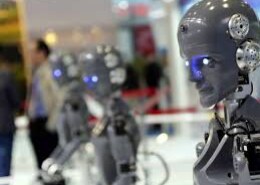The world is experiencing a transformative shift in the realm of automation, largely propelled by advancements in robotics technology. From manufacturing industries to healthcare, from household chores to space exploration, robots are increasingly becoming an integral part of our daily lives. This article aims to explore the latest developments in robotics, showcasing the remarkable strides made in this field and their impact on various sectors.
Here are some of the latest developments in robotics and their impact across different sectors:
1. Healthcare Robotics:
Surgical Robots: Advancements in surgical robotics continue, with more precise and minimally invasive procedures. Robots like the Da Vinci Surgical System assist surgeons in intricate surgeries, reducing patient trauma and recovery times.
Robotic Rehabilitation: Devices and robots aid in physical therapy and rehabilitation, helping patients regain mobility after injuries or surgeries.
Telemedicine Robots: Robots equipped with cameras and communication tools enable remote healthcare delivery, allowing doctors to interact with and diagnose patients from a distance.
2. Manufacturing and Industry:
Collaborative Robots (Cobots): Cobots work alongside human workers, streamlining production lines and enhancing productivity in manufacturing industries. They contribute to safer work environments by handling repetitive or hazardous tasks.
3D Printing Robots: Robots are increasingly utilized in 3D printing, allowing for intricate designs and faster production, impacting industries from aerospace to healthcare.
3. Service and Hospitality:
Customer Service Robots: In retail and hospitality, robots assist with tasks like customer inquiries, room service in hotels, and inventory management in warehouses.
Autonomous Cleaning Robots: Robots are deployed for cleaning and maintenance purposes in various settings, reducing manual labor and ensuring hygiene.
4. Agriculture and Farming:
Agribots: Robots aid in precision farming, performing tasks like planting, harvesting, and monitoring crop health. They contribute to increased efficiency and reduced labor requirements in agriculture.
5. Logistics and Warehousing:
Autonomous Vehicles: Robotics plays a crucial role in autonomous vehicles used for transportation and delivery. Companies are developing drones and self-driving vehicles for efficient and faster logistics operations
6. Space Exploration:
Planetary Rovers: Robots like NASA’s Perseverance rover and ESA’s Rosalind Franklin explore celestial bodies, conducting experiments and collecting data in extraterrestrial environments.
7. Personal Assistance and Companion Robots:
Elderly Care Robots: Robotics contributes to elderly care by providing companionship, monitoring health, and assisting with daily tasks for aging populations.
These developments in robotics showcase their transformative impact across diverse sectors, improving efficiency, safety, and precision while addressing specific industry challenges. As technology continues to advance, the integration of robotics with AI, machine learning, and IoT promises further innovation and expanded applications in the near future.
Trending growth in the robotics industry
The robotics industry is experiencing significant and trending growth, driven by technological advancements and increased adoption across various sectors. Several key factors contribute to this burgeoning growth:
Technological Advancements: Rapid progress in artificial intelligence, machine learning, sensors, and materials science has propelled the development of more sophisticated and versatile robots. These advancements enable robots to perform complex tasks with increased accuracy, autonomy, and adaptability.
Increased Automation Demands: Industries are increasingly turning to automation to enhance productivity, efficiency, and precision while reducing costs. Robotics provides solutions for streamlining manufacturing processes, logistics operations, healthcare services, and more, meeting the growing demand for automation across sectors.
Collaborative Robotics: The rise of collaborative robots (cobots) that work alongside humans in shared workspaces is a significant trend. These robots offer enhanced safety features and flexibility, making them valuable assets in industries where human-robot collaboration is necessary.
Diverse Industry Applications: Robotics is expanding its footprint across diverse industries such as manufacturing, healthcare, logistics, agriculture, space exploration, and consumer services. This broad applicability signifies the versatility of robotics solutions in addressing industry-specific challenges.
Investment and Innovation: Increased investment from both public and private sectors in robotics research and development fuels innovation. Startups and established companies alike are focusing on creating innovative robotics solutions, contributing to the industry’s growth and competitiveness.
Demand for AI-Powered Robotics: Integration of artificial intelligence with robotics is a prominent trend. AI-powered robots capable of learning, adapting, and making autonomous decisions are in high demand, enabling more sophisticated functionalities and applications.
Rise of Autonomous Vehicles and Drones: The development of autonomous vehicles, including self-driving cars, trucks, and drones, showcases the expansion of robotics in transportation and logistics, opening new avenues for growth and innovation.
In conclusion, the evolution of robotics and automation represents a pivotal moment in shaping the future of industries, services, and daily life. The remarkable advancements in robotics technology, coupled with the integration of artificial intelligence, machine learning, and connectivity, are revolutionizing the way tasks are performed and services are delivered across various sectors.
From manufacturing and healthcare to transportation, agriculture, and beyond, the impact of robotics is profound. Smart factories, collaborative robots, autonomous vehicles, and AI-driven systems are optimizing processes, increasing efficiency, and transforming traditional practices. Robotics is not only streamlining operations but also enhancing safety, precision, and scalability in diverse industries.
The future holds immense promise for robotics and automation. With ongoing innovation, we anticipate further advancements such as enhanced healthcare procedures, personalized services, smarter agricultural practices, and exploration of extreme environments with minimal human risk.
However, as this technological revolution unfolds, it’s crucial to address ethical considerations, ensure proper regulations, and manage the potential impact on the workforce. Collaborative efforts are necessary to harness the full potential of robotics while mitigating risks and ensuring a balanced integration of these technologies into society.
Ultimately, the future applications of robotics and automation hold the potential to create a more efficient, interconnected, and technologically advanced world, reshaping industries, improving standards of living, and unlocking new possibilities for innovation and human advancement.

